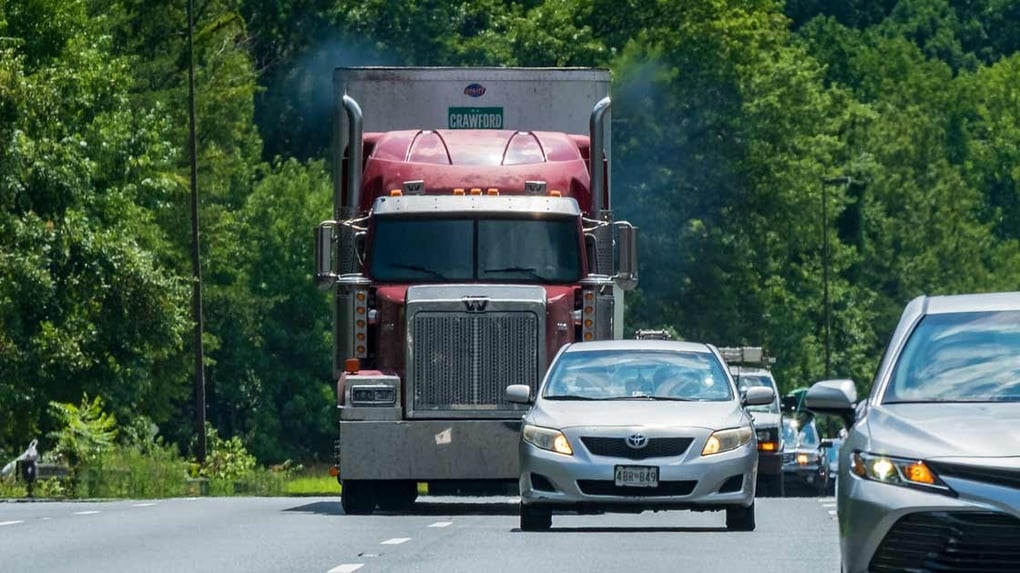 Credit: Insurance Institute for Highway Safety. A new study from the Insurance Institute for Highway Safety suggests that equipping large trucks with forward collision warning and automatic emergency braking (AEB) systems could eliminate more than 2 out of 5 crashes in which a large truck rear-ends another vehicle. The group is recommending that these crash avoidance systems become standard equipment on new trucks. IIHS Study DataAccording to the IIHS news release, the group looked at data on crashes per vehicle mile traveled from 62 carriers operating tractor-trailers and other trucks weighing at least 33,000 pounds. IIHS Director of Statistical Services Eric Teoh found that trucks equipped with forward collision warning were involved in 22 percent fewer crashes. Trucks with AEB had 12 percent fewer crashes than those without either technology. The numbers were even greeted with forward collision warning and AEB reduced rear-end crashes � the specific type of collision they�re designed to prevent � which decreased by 44 and 41 percent, respectively.IIHS researchers say even though truck drivers crash less, per mile traveled, those crashes can be especially deadly because trucks can weigh 20-30 times as much as passenger vehicles. U.S. crashes involving large trucks hit an all time low in 2009, but have risen by nearly a third since then, killing 4,136 people in 2018 according to the IIHS. Among those fatalities, 119 deaths resulted from large trucks rear-ending passenger vehicles. The study covered some 2,000 crashes that occurred over more than 2 billion vehicle miles traveled during 2017-19. Incidents that didn�t cause injuries or significant property damage were excluded. �This study provides evidence that forward collision warning and AEB greatly reduce crash risk for tractor-trailers and other large trucks,� Teoh says. �That�s important information for trucking companies and drivers who are weighing the costs and benefits of these options on their next vehicles.� Front Crash Prevention and Automatic Emergency BrakingFront crash prevention systems use cameras, radar or other sensors to monitor the roadway ahead. Some include only forward collision warning, which alerts the driver to obstacles in the roadway. AEB systems, which you can read more about in a Car Pro post here, go further � automatically applying the brakes to prevent the collision or reduce its severity.The European Union has required AEB with forward collision warning on most new heavy trucks since November 2013. Those systems aren�t a requirement in the U.S., however, 20 automakers that account for 99 percent of the U.S. market are moving toward making AEB standard on virtually all new passenger vehicles by Sept. 1, 2022, under a voluntary commitment brokered by IIHS and the National Highway Traffic Safety Administration. Crash Prevention BenefitsCrash prevention systems work. For passenger vehicles, studies conducted by IIHS and the Highway Loss Data Institute have documented significant benefits from AEB. An IIHS study of police-reported crashes showed that front AEB cuts rear-end crash rates in half and rear-end crashes involving injuries by 56 percent. Meanwhile, HLDI has found that AEB cuts property damage liability claims, as well as claims for injuries to people in other vehicles.In the new study involving large trucks, Teoh compared trucks from the same carriers that were equipped with forward collision warning alone, AEB, and no front crash prevention at all. AEB systems generally include forward collision warning too. For the first time, the Institute drew on data compiled by SmartDrive Systems, a video-based safety program for commercial fleets. SmartDrive was able to determine which trucks were equipped with forward collision warning and AEB and collect detailed information about crashes. Using data collected by a third party helped to minimize data differences among carriers that might have influenced the results. �The transportation intelligence we�ve gathered over the past 15 years provides unique and deep insights on the trucking industry,� says Jason Palmer, chief operating officer of SmartDrive Systems. �We�re proud to put this data to use to support IIHS with this important and timely study of the benefits of front crash prevention.� The similar benefits of forward collision warning and AEB that Teoh observed for rear-end crashes were unexpected, since studies of passenger vehicles have shown AEB to be much more effective than systems that only issue warnings. The IIHS says that could reflect differences in how and by whom trucks and passenger vehicles are driven, or it might be connected to variations among the specific systems used by each carrier. The study indicated that AEB and forward collision warning could do more than reduce crashes. Researchers say it could also lessen the severity of crashes that still occur due to a reduction in speed, whether it�s due to AEB systems or a driver that has more time to react because of a warning. In reviewing the trucks in rear-ended collisions, Teoh found that either system resulted in speed reductions of more than 50 percent between the warning or automatic braking and the impact. �The potential benefits are great enough that these crash avoidance systems should be standard equipment on all new large trucks,� says IIHS President David Harkey. Click here to read the IIHS research paper. |
|
|
|

Study: Collision Warning Preventing 18-Wheeler Crashes
Written By: Jerry Reynolds | Sep 9, 2020 12:00:00 AM

From police officer to top-selling Ford dealer to on-air car expert, Jerry helms our weekly radio show. Since selling his dealerships in 2006, Jerry has pursued his top three passions: helping consumers have a great car buying experience, supporting the military and first responders, being a loyal servant to his dog! While Jerry admits to hitting the pedal to the metal on test drives, it's all the service of finding out just how fast he can go from 0 to 60.